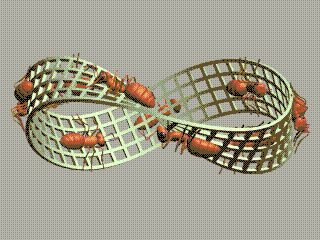A Möbius strip is a simple and fascinating figure that connects two ends of a rectangular strip in such a way that there is only a single edge and a single side. As we get to the end of a school term, and as I end my two years in Singapore, it’s an appropriate image for illustrating the integration of ends and beginnings. We might see some things as ending and others as beginning, but actually the whole of life is one unbroken reality, as mysterious as it is obvious.
One example of this is found in the making of major decisions in life. Those who get married or commit themselves to a particular way of life think that they are limiting their options, ending their freedoms, and restricting their future choices. Yet those who fully engage new life realities in their major decisions discover that their options have widened, their freedoms have increased, and their choices have become much more meaningful. (My Singapore fling is just one such example.)
Richard Niehaus once wrote that “we act in the courage of our uncertainties.” The word decide comes from the Latin decider, “to cut off.” In deciding “you have cut off the alternatives and pray you have decided rightly. But you do not know for sure. Or else you are trapped in the tangled web of indecision. He then quotes 1 Cor 4:3-5 “But with me it is a very small thing that I should be judged by you or by any human court. I do not even judge myself. … Therefore do not pronounce judgment before the time, before the Lord comes, who will bring to light the things now hidden in darkness and will disclose the purposes of the heart.” When we make a choice, we enter a depth dimension of life and open up a whole new web of possibilities, previously unseen and unknown. It’s only later that one can say: “That was the best decision I ever made.”
The fact is that one’s interests, priorities, and values emerge in whatever choice is made in life. Gradually, these come to the fore and either colour or hijack the particulars of your life such that the inner core of your soul’s interest – otherwise known as your vocation – emerges to blossom in the soil where it finds itself planted. So there is little to worry about in this respect. Make the decisions that you are invited to make, respond to the people and situations that invite your response, and step into that uncertain future with a core confidence, one that becomes more real and steady as it is expressed and lived out. But keep feeding the soul.
I keep only one little sign on my desk. It is one that I found in a small shop years ago and that I still find meaningful. It reads “What would you start to do if you knew that you could not fail?” This is the sort of sentiment that invites engagement, the doing of things. Because it is only in the doing that you can set the conditions for your future positive decisions. You cannot see around the corner, but you can get yourself to the corner so as to see what lies beyond. This approach is particularly helpful in difficulties, as expressed in one of my favorite poems and hymns: “Lead, kindly Light, amid the encircling gloom, // Lead Thou me on! // The night is dark, and I am far from home // —Lead Thou me on! // Keep Thou my feet; I do not ask to see // The distant scene—one step enough for me.” (John Henry Newman)
Ends and beginnings are two sides of the Möbius strip of life’s journey. Don’t try to peek over the edge. Instead, enjoy what is there, pursue what is important, and keep moving on.
